I hope this is appropriate here. I figured it fits the general theme of things considering if we’re self hosting there’s gotta be some hardware involved.
I’ve got a house built in the 1960s US. I’m working on upgrading my security infrastructure to a PoE system as my previous choice of wireless system was a poor decision on my part. I have all my ‘gear’ if you will in the basement but I don’t have any convenient drops from the attic to my basement. I need to do a total of 8 drops from attic to basement. I’m not too versed in wiring things through a home (ie. minimal damage to walls and such) I’ve done long runs in warehouses but that was essential all open space.
My main questions are:
- is there any specific conduit I should be looking at to pull the runs through the walls?
- Is there any specific tools that I need to know about to make this job easier? I assume one of those line pullers would be handy in this case ( the hell are they actually called?
- Any other tips and tricks from those of you who have done something similar?
O man, this is one of my jamb’s!
- Conduit: not required, you can run through walls with cable, but!!! Any time I open up a wall for any reason I run conduit. I chose to run metal so I can run power in the future. Running “smurf tube” or PVC is perfectly ok for networking. The big advantage of conduit is that you can leave a pull string and/or fish new cables easily until its full
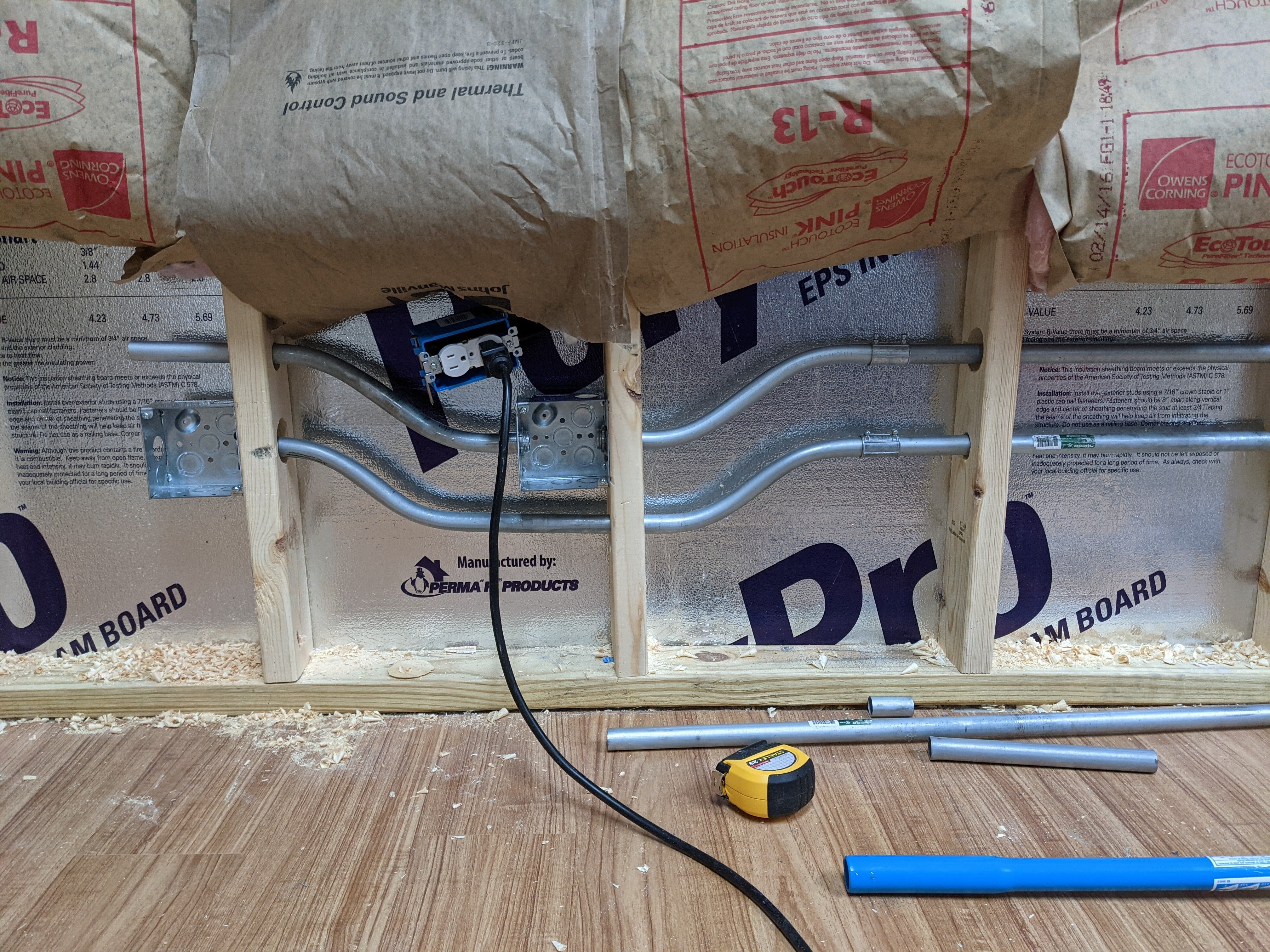
- YES!
- Sharpie before all other tools ALWAYS LABEL THE CABLE BEFORE YOU PULL IT. If you dont you will be testing later on with more expensive tools to figure out which cable is which. A Sharpie is cheep.
- Side cutters/cable cutters, or utility scissors (my recommendation) these are needed to cut cables, strip off jackets, and cut kevlar/thread or plastic core. https://www.bhphotovideo.com/c/product/1718739-REG/jonard_tools_es_1964_electrician_s_scissors.html
- RJ45 Crimp tool, you can do pass through ends or not thats up to you, but get good ones they are worth the investment. https://www.bhphotovideo.com/c/product/1043092-REG/eclipse_tools_902_354_network_tool_bundle.html
- Drywall Saw https://www.homedepot.com/p/Klein-Tools-6-in-Drywall-Saw-with-Plastic-Handle-725/100647777
- Fish tape or glass rods (I prefer fish tape) 25’ or 50’ are fine for home use.https://www.bhphotovideo.com/c/product/1718757-REG/jonard_tools_fts_50_steel_fish_tape.html
- Lightweight cordless drill, I like Milwaukee but there are plenty of options https://www.homedepot.com/p/M12-FUEL-12-Volt-Lithium-Ion-Brushless-Cordless-Hammer-Drill-and-Impact-Driver-Combo-Kit-w-2-Batteries-and-Bag-2-Tool-3497-22/320268525
- Heavy duty corded drill (hammer suggested) https://www.homedepot.com/p/DEWALT-7-8-Amp-Corded-1-2-in-Variable-Speed-Reversible-Hammer-Drill-DW511/100037000
- Paddle bits, get at least one long one so you can get through wall top-plates https://www.homedepot.com/p/Milwaukee-High-Speed-Wood-Spade-Bit-Set-13-Piece-48-27-1520/305537862 https://www.homedepot.com/p/Bosch-Daredevil-1-in-x-16-in-Spade-Bit-DLSB1013/203274545
- I also like wood boring bits https://www.lowes.com/pd/BLACK-DECKER-Marples-14-Piece-Woodboring-Drill-Bit/1003008984
- Pull string, every time you pull a drop, pull some string so you can run more lines in the future! https://www.homedepot.com/p/Gardner-Bender-1-8-in-x-6500-ft-L-210-lbs-Strength-Poly-Pull-Value-Blow-Line-in-a-Bucket-PL132B/313821648
- Use interior walls as much as you can. Very often you can find closet walls and interior walls that have almost no electrical in them and have no insulation which makes running cable very easy. I would avoid exterior walls as drilling into the top plate near the roof line is a tight space and running fish tape with insulation is a pain in the butt.
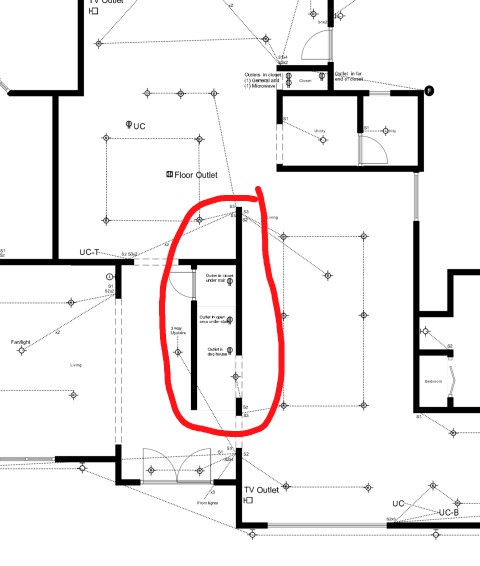 Example of a decent interior wall that should go from basement to attic even on a multi story house.
Example of a decent interior wall that should go from basement to attic even on a multi story house.I like to use low cost bike hooks to keep my cables off the ceiling in the attic that way im not walking all over them they are very affordable but are not great for long pulls as they drag on the cable jacket. https://www.homedepot.com/p/Everbilt-Vinyl-Coated-Steel-Screw-In-Bicycle-Hook-25-lbs-21407/206585761 real J Hooks that are designed for cable are $$$ https://www.homedepot.com/p/ICC-3-4-in-J-Hook-ICC-ICCMSJHK22/204517525.
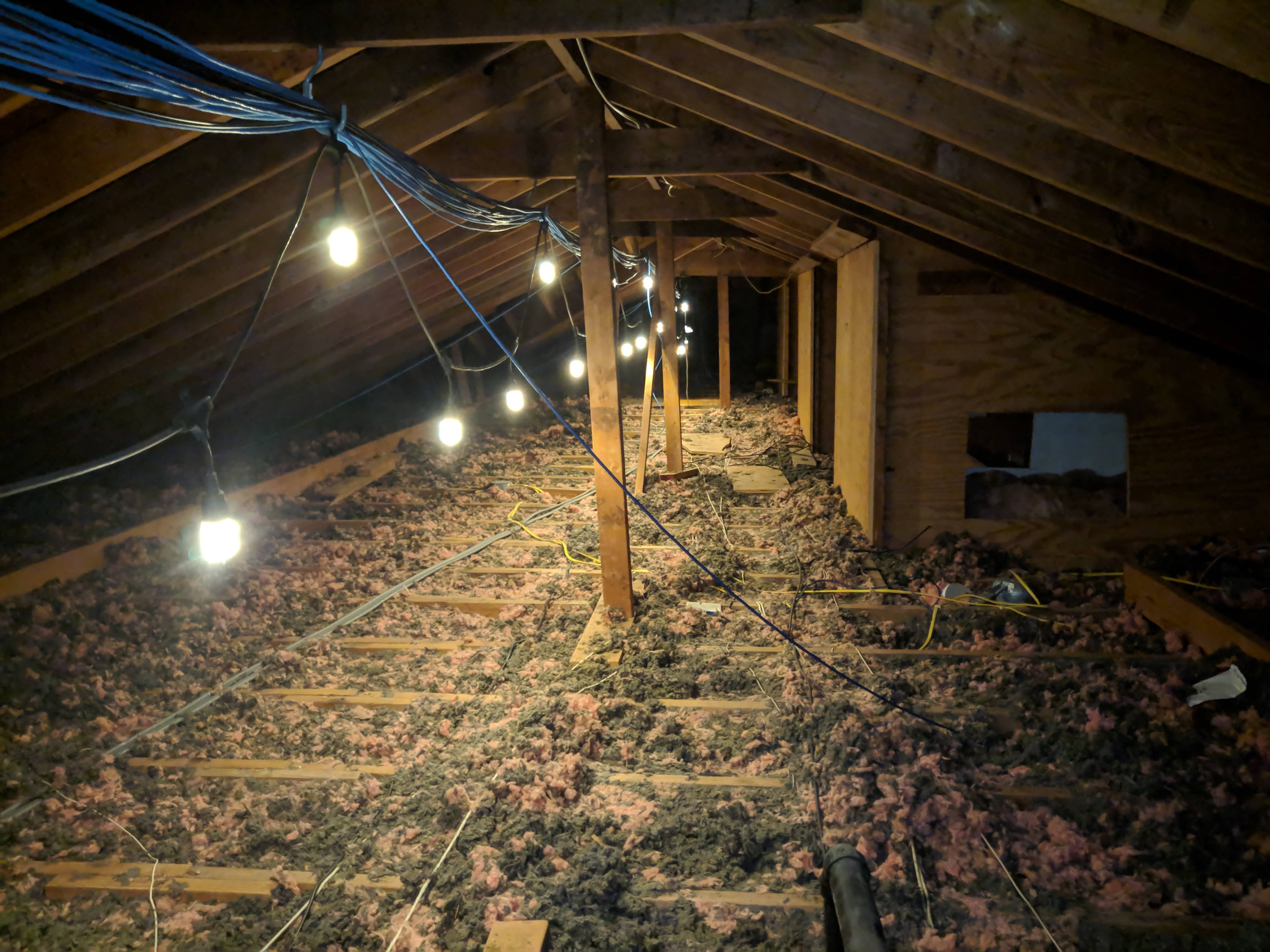
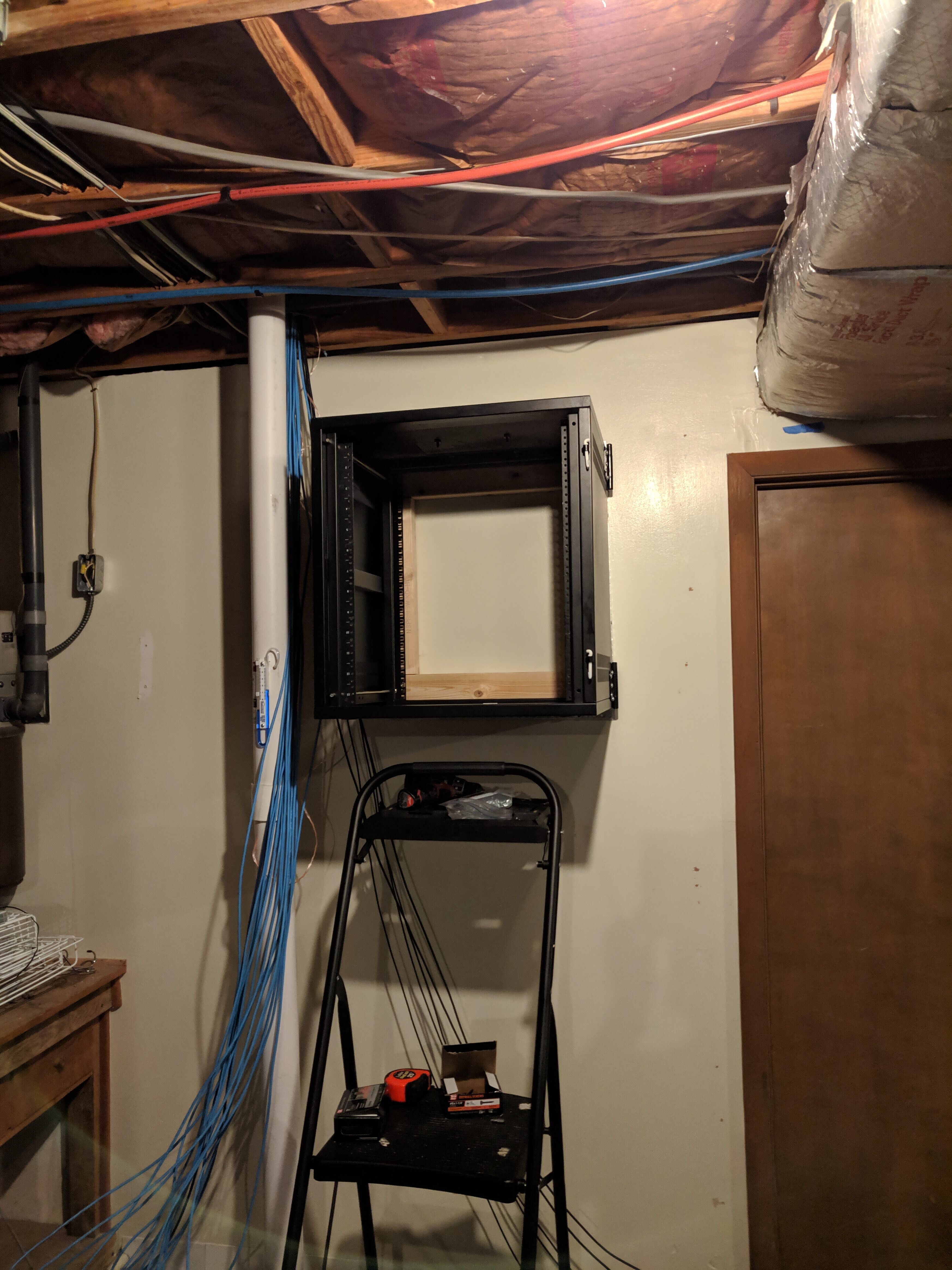
I ended up installing 2x 3" PVC conduits from my basement rack through a closet wall into the attic. From there I run cable through the bike hooks until I get to the wall I need to do the drop in, and then I drill a hole in the wall top plate and drop my cables down that wall.

I always try to drop my cables along side a vertical stud so I will cut into the wall BEFORE i run cable and do so directly adjacent to the stud. I dont install the box until the cable is run, but I use the cheap new construction boxes https://www.homedepot.com/p/Carlon-1-Gang-18-cu-in-Blue-PVC-New-Work-Electrical-Switch-and-Outlet-Box-B118A/202546986 and just cut the nails off rather than use more expensive “old work” boxes https://www.homedepot.com/p/Carlon-14-cu-in-PVC-Old-Work-Electrical-Outlet-Box-1-Gang-B114RB/100404027
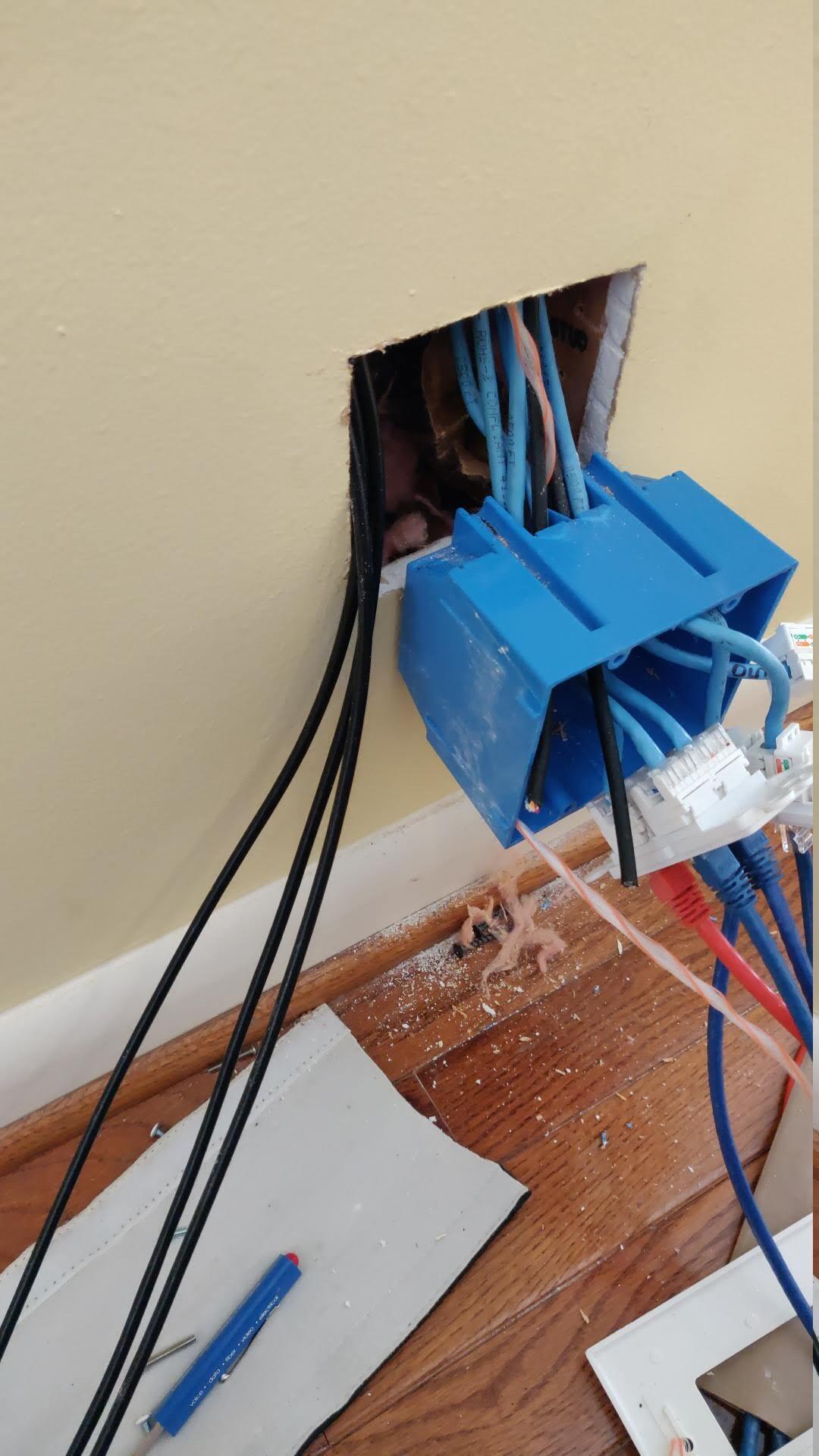
Some drywall screws in the side of the box going into the stud are more than enough to secure it.
When cutting the box in I find the stud (use a magnet, never trust a stud-finder) measure to the middle of any existing boxes or outlets. I then measure that hight out about about 1" from where I expect to find the stud, and I cut in the direction of the stud with my drywall saw. Once I hit the stud I pull out the saw, and I align the box center to the cut, and the edge to the vertical stud. I trace the outline of the box using a pencil and then cut along that line. If you do it this way it should end up level, the same height as other outlets/boxes, and be permanently secured so it wont fall out like some of the cheap low voltage cutin’s that cable companies LOVE.
Holy shit this is going to help me out! Thank you so fucking much man, definitely saved my ass more than once! Lol.
Side note : The photo embeds are amazing on Lemmy, idk if it’s just me but I way prefer it to Reddit.
Any advice for Victorian era terraced houses in the UK where every wall is solid brick :/
Yep, big fucking hammer drill and drill bit. Make sure you have some solid ear protection and kick everyone out of the house while you drill.
Yeah ended up doing that in a couple of places, for me its not practical to have bundles of cable running from a central switch, because of having to run a cable through a hole in the wall, hiding it behind skirting boards (baseboards) and under floors (where there are crawl spaces). My work place is based in a really old building and theres just bundles of ethernet everywhere running across floors and loosely attached to walls etc, wish they spent the time, effort and money of equipment running fewer 10Gb runs to floors then having 10Gb to 1Gb switches for the workstations.
That is hard :( I did a bit of work with an 1880’s Victorian but that was in the North East US so it was plaster and horsehair but hallow walls even on the outside.
Do you want to take some pictures and I can see if there is anything I can think of? Chances are if they plastered right on top of brick/stone than pulling off the baseboard like you did and running everything behind them may be your only option for hiding cables.
Nah, thanks but I think I’ve got a handle on the options, my original reply was more a tongue-in-cheek “cries in brick wall” type thing. I mean it has its positives, I could hang a wall mounted rack anywhere without any prep or checking :)
Wb the ceiling? Then paint the wire to match the walls LMFAO. I’ve also seen people cut channels in drywall then spackle over the wire (this can be a problem if you go to hang something though…)
Yeah the correct way to do it is to chisel a channel in the plaster and embed the cable in the plaster, but thats quite an ordeal to do.
HOW DO I GIVE YOU GOLD?
Excellent write-up - exactly what us nerdy new home-owners need! :D
https://www.patreon.com/discussonline/posts
https://opencollective.com/discussonline
You could do a 1 time donation to my instances admin to help him cover hosting costs!
-
Generally conduit is not required in code for low voltage communications wire. It certainly helps, because you can jam a piece of rigid conduit straight up through a wall easier, and it allows you to seal the hole on either end to prevent any air or pest intrusion. But it’s extra cost and labor. You can use standard grey PVC conduit from a hardware store if you wish.
-
It’s called fish tape. Definitely will want some.
-
Buy bulk cable and pull it bare then terminate the ends at a patch panel. Pulling preterminated patch cables is a recipe for a bad time. If you use conduit, buy conduit a size or two larger than you think you need.
Depending on the complexity of the runs- don’t br afraid to call an electrician. They have magic ways of getting wires to places.
Will absolutely keep this in mind. I have a buddy in the business I will reach out to him and get some of his thoughts on it.
-
I live in a single-level house in the US, also built in the 1960s. I don’t have a basement, but I do have a crawlspace under the house. I had never ran cables before but I found it pretty straightforward to run cables through the crawlspace. My attic is very very small and nothing runs through it - all the electrical cabling and HVAC ducting is under the house.
I’ll leave you with some miscellaneous tips.
Use CMR-rated pure copper CAT6 cables. Don’t use CCA (copper clad aluminium). I’ve had good experience with trueCABLE on Amazon; both their CMR-rated cable and their outdoor / direct burial CMX-rated cable. I use the latter for outdoor security cameras.
You’ll want some low-voltage old work brackets (I bought these ones from Home Depot, ~$2.50 each), some faceplates (I usually use Legrand On-Q ones for ~$0.80-$1 each), some Keystone jacks (I used TRENDnet ones, ~$30 for 25 of them). Try to use keystone jacks where possible - only use RJ45 connectors if you really need to. With the jacks I linked to, you don’t need a punchdown tool; they’re tool-less.
The low voltage brackets have little holes in each corner. Place the flat part against the wall, ensure it’s level, around the same height as the power outlets, and NOT over a stud. Stick a pencil in each little hole and wiggle it a bit to mark the corners. Cut a hole in the wall with a drywall knife (I usually create a few starter holes with a drill) and install the bracket. In my case, I used a long drill bit inserted into the hole to drill through the floor/subfloor into the crawlspace and ran the wire through there. I didn’t use conduit.
Secure the cables. I use these multi-cable staples to secure them in the crawlspace. If you’re running cables through the crawlspace, don’t be lazy and just leave them sitting on the ground :D
Use spray foam to fill holes to ensure drafts and bugs don’t go through it. I use this fireblock one.
Get a cheap Ethernet cable tester with a screen. I’ve got this one that cost $35. Apparently it’s no longer sold, however it looks like there’s clones of it. If there’s an issue with any of the wires in the cable, it shows you which wires are wrong and if they’re crossed (connected to the wrong pin) or not connected at all.
Don’t bother with CAT6a. CAT6 is easier to deal with and supports 10Gbps with cable runs up to 55 meters, which is more than enough for residential unless you live in a giant mansion. The cable I linked to can go a bit longer an still maintain 10Gbps speeds.
I will always disagree with the old work brackets. They cost 3x as much and never hold as well as just drilling an new work box into a stud. just cut off the wings/nails on the new work box so it fits in the drywall hole.
We’ve used trueCABLE here at work as well with good results, thanks for the specifics as I generally do most of the grunt work and am removed from the more technical aspects of the ordering so the details here are greatly appreciated.
The other thing I forgot to mention is that in my house at least, there’s horizontal wood between the studs about half way up the wall. I guess as a fire block, like this: https://www.oneprojectcloser.com/fire-stops-fire-blocking-in-studs but thicker. That would have made it a lot harder for me to run cables to the attic, since I’d have to drill a hole through it. That and the fact that my attic isn’t very tall (some parts of it are only a few feet tall) made the crawlspace the obvious choice.
I was also a bit scared drilling through the floor into the crawlspace and was worried I was doing something wrong since it was taking a while, but it turns out the subfloor is just very thick and so it takes a while to drill through it.
My advice. Call a local electrician or small business networking company; get some quotes for what you are looking for. Have 2 cables run from the network interface box to where your router/firewall is in addition to a second location in case you ever need to expand the network setup in you home. The cost is well worth not worrying about pulling cables. Install CAT6 boxes in almost every room you foresee a cable ever being run. Good luck! I recently rewired my home with CAT6 from the fiber interface box and am now enjoying 900/850mb everywhere in my home.
I agree with this. Get some quotes and if you can afford it then have a professional do the runs. Pulling wire through existing walls is a pain and then add in crawling through the attic.
I paid about 1200 to have 10 Ethernet lines ran; 8 poe for security and 2 data lines to my computer work area. I think it was worth it so I didn’t have to crawl though my hot itchy attic lol





